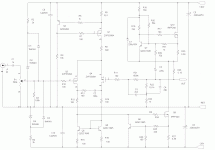Anybody checked out MOSFET pairs? I wonder how closely they are Vgs matched?
SN74AHCU04N inverters usually match well within 4 mV, see https://www.diyaudio.com/community/...eap-fet-differential-pair.228957/post-3347847
Speaking of matched MOSFET pairs (or even quads), I've been eyeing the Advanced Linear Devices'... erm... devices 😉 for quite a while know - they come in N, P or N-P flavours, typically matched to 2mV Vgs(th) offset and 0.5-2% Gfs mismatch (a few sample data sheets attached). Anybody had a chance to try them out already?
Attachments
I have used matched MOSFETS in input stages for ages. It doesn't take too big of a pile of MOSFETs to get decent input pair matching. I glue the input MOSFETs together with a loaded epoxy like JB Weld/ JB Kwik to get thermal sharing between the two sides of the differential input pair. The input gate side is protected with a biased diode/ Zener arrangement of my own design that reduces input stage capacitive loading.
Right, with the same loop gain, the THD of the whole amp would be same. The THD of the output stage dominates and the input stage doesn’t matter.With different transistors in input LTP stage.
I have examinate THD.
BJT, JFET and MOS all show the same THD.
So, my conclusion is that it does not matter what transistors I use in input stage.
There is one caveat. With BJT, the loop gain changes with the signal impedance, because the input impedance at the BJT base cannot be ignored. It forms a voltage divider at the input. If the signal source is a volume pot, the loop gain changes with the position of the volume pot. That will affect the THD.
I prefer mosfet over jfet in the context of line level input of the power amp, because the mosfets have higher voltage rating and the noise figure doesn’t matter much.
Last edited:
Here's the thread that spawned the schematic in post 24
Here's a variant on Grey Rollin's Aleph Mini.
I've added a protection network at the input to prevent some dumbjohn from shuffling across the carpet and dusting the input via ESD.
I changed the input diff pair to the Zetex p-channel devices to reduce the capacitance at the input.
The current source at the tail of the diff input pair has been changed to a "ring of two" source to eliminate the need for selecting the mosfet feeding the diff pair tail.
The mosfets in the diff pair will still need to be closely matched - the degree of match will dictate the output offset of the...
I've added a protection network at the input to prevent some dumbjohn from shuffling across the carpet and dusting the input via ESD.
I changed the input diff pair to the Zetex p-channel devices to reduce the capacitance at the input.
The current source at the tail of the diff input pair has been changed to a "ring of two" source to eliminate the need for selecting the mosfet feeding the diff pair tail.
The mosfets in the diff pair will still need to be closely matched - the degree of match will dictate the output offset of the...
- Home
- Amplifiers
- Solid State
- MOSFET vs JFET in The Input Stage
